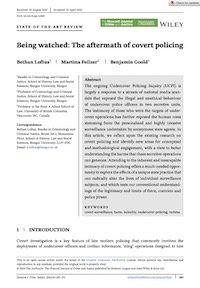By Sarah L. Desmarais, Eva McKinsey, Ethan Rex, and Jessica Smith
Executed by the North Carolina Association of Chiefs of Police (NCACP), UNC School of Government Criminal Justice Innovation Lab (the Lab), Policy Research Associates (PRA), and North Carolina State University (NCSU), the Citation Project sought to improve policing practices through implementation and rigorous evaluation of a model Citation in Lieu of Arrest Policy. On December 1, 2020, four North Carolina police departments implemented the project’s model policy: Apex, Elizabeth City, Wilmington, and Winston-Salem. The evaluation of the model policy examined four questions.
Was the model policy implemented consistently according to its guidelines and recommendations? Our findings indicate challenges with implementation that primarily reflected limited patrol officer buy-in. Despite multiple implementation strategies and consistent buy-in from leadership, some patrol officers expressed discontent with the model policy. This response, along with relatively low completion of required documentation in warrantless arrest encounters, limits our ability to evaluate the impact of the model policy.
Did the model policy increase the use of citations in policy-relevant encounters without increasing involvement of individuals in the criminal justice system? Overall, there was no increase in citation rates following implementation of the model policy. In two pilot sites, citation rates decreased after implementation. When evaluating encounters by offense type, we found that citation rates for traffic offenses were over 98% even before implementation of the model policy, signaling a ceiling effect on any potential impact. Only one site had an increase in citation rates for traffic offenses; the others had no change. We found no meaningful increases in citation rates for the other two offense types examined: non-violent and violent misdemeanors. We also found that the number of encounters over time across all sites decreased. Put another way, there was no evidence of increased involvement in the justice system. This decrease in encounters was likely due to external factors such as COVID-19 and social protests, which stakeholders identified as affecting policing practices.
Did the model policy result in the administration of citations in an equitable manner by race/ethnicity? We found that citation rates did not increase for any racial/ethnic subgroup following implementation of the model policy. Instead, the citation rate decreased for Black people in one site and for both Black and White people in another. We also found that differences across races did not change over time. Finally, although the policy was not designed to address racial differences in overall encounters, we examined that issue for context. We found that in three sites, Black people were significantly overrepresented in misdemeanor encounters with the police and White people were significantly underrepresented.
Did the model policy reduce the amount of time that police and equipment are removed from service during an encounter? Officers saved an average of over ninety minutes per encounter when choosing to cite instead of arrest. However, because of low completion of required documentation in warrantless arrest encounters, the data used for this calculation may not be representative of all encounters covered by the model policy.
Several important qualifications and limitations apply to these findings. These include external factors, such as the impact of the COVID-19 pandemic and periods of social unrest, that overlapped with implementation of the model policy; implementation challenges; overall decreases in misdemeanor charging during the study period; and characteristics of the pilot sites, such as attitudes towards citation in lieu of arrest.
We conclude this report with recommendations for new or continuing implementation of citation in lieu of arrest initiatives. These recommendations include:
1. Conduct a needs assessment and use it to develop a targeted policy.
2. Conduct an organizational assessment to determine whether to implement a policy and how to do so.
3. Use implementation lessons learned from this evaluation to supplement organizational assessment results.
4. Continue to assess and address issues of racial/ethnic equity.
University of North Carolina, School of Government, 2023. 38p.





















